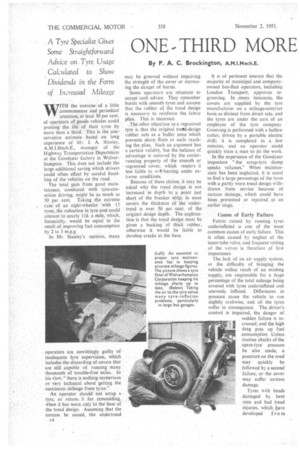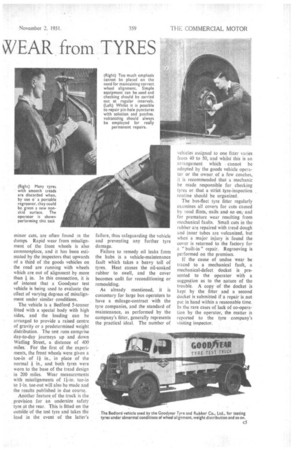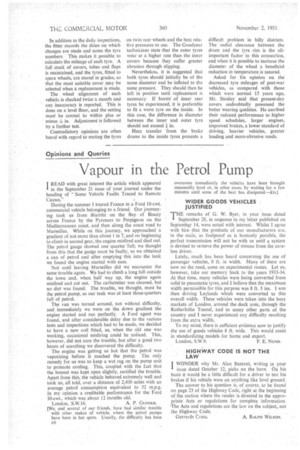ONE-THIRD MORE WEAR from TYRES
Page 42

Page 43

Page 44

If you've noticed an error in this article please click here to report it so we can fix it.
By P. A. C. Brockington, A.M.! ech .E. A Tyre Specialist Gives Some Straightforward Advice on Tyre Usage .Calculated to Show Dividends in the Form of fru-eased Mileage WITH the exercise of a little commonsense and periodical attention, at least 30 per cent. of operators of goods vehicles could prolong the life of their tyres by more than a third. This is the conservative estimate based on long experience of Mr. J. A. Stanley, A.M.I.Mech.E., manager of the Highway Transportation Department at the Goodyear factory in Wolverhampton. This does not include the large additional saving which drivers could often effect by careful handling of the vehicles on the road.
The total gain from good maintenance, combined with tyre-consciOus driving, might be as much as 50 per cent. Taking the extreme case of an eight-wheeler with 12 tyres, the reduction in tyre cost could amount to nearly lld. a mile, which, financially, would be equal to the result of improving fuel consumption by 2 to 3 m.p.g.
In Mr Stanley's opinion, many operators are unwittingly guilty of inadequate tyre supervision, which includes the discarding of covers that are still capable of running many thousands of trouble-free miles. In his view," there is nothing mysterious or very technical about getting the maximum mileage from tyres."
An operator should not scrap a. tyre, or return, it for remoulding. when it has worn only to the base of the tread design. Assuming that the carcass be sound, the undertread c4 may be grooved without impairing the strength of the cover or increasing the danger of bursts.
Some operators are reluctant to accept such advice. They remember bursts with smooth tyres and assume that the rubber of the tread design is necessary to reinforce the, fabric plies. This is incorrect.
.The other objection to a regrooved tyre is that the original treatd-design rubber acts as a buffer zone which prevents sharp flints or nails reaching the plies. Such an argument has a certain validity, but the balance of advantage is restored by the coolerrunning property of the smooth or regrooved cover, which renders it less liable to overheating under extreme conditions.
Because of these claims, it may be asked why the tread design is not increased in depth to a point just short of the breaker strip; in most covers the thickness of the undertread is over 50 per cent. of the original design depth. The explanation is that the tread design must be given a backing of thick rubber, otherwise it would be liable to develop cracks at the base. It is of pertinent interest that the majority of municipal and companyowned bus-fleet operators, including London Transport, approves regrooving. In _many instances, the covers are supplied by the tyre manufacturer on a mileage-contract basis as distinct from direct sale, and the tyres are under the care of an employee of the tyre company. Grooving is performed with a hollow cutter, driven by a portable electric drill; it is completed in a few minutes, and an operator could quickly train a man to do the work.
In the experience of the Goodyear inspectors "the scrap-tyre dump speaks volumes." When maintenance has been neglected, it is usual to find a large percentage of the tyres with a partly worn tread design withdrawn from service ' because of carcass damage, which could' have been prevented or repaired . at an earlier stage.
• Cause. of Early Failure
Fabric ruined by running tyres underinflated is one of the most common causes of early failure. This is often caused by neglect of the inner-tube valve, and frequent vetting of the valves is therefore of first importance.
The lack of an air supply system, or the difficulty of bringing the vehicle within reach of an existing supply, are responsible for a large percentage of the total mileage being covered with tyres underinflated and unevenly inflated. Differences in pressure cause the vehicle to run slightly crabwise, and all the tyres suffer in consequence. The driver's control is impaired, the danger of sudden failure. is increased, and the high drag puts up fuel consumption Unless routine checks of the spare-tyre pressure be also made, a puncture on the road may quickly be followed by a second failure, or the cover may suffer carcass damage.
Tyres with beads damaged by bent rims and bad tread injuries, which have
developed f r o.na
minor cuts, are often found in the dumps. Rapid wear from misalignment of the front wheels is also commonplace, and it has been estimated by the inspectors that upwards of a third of the goods vehicles on the road are running with wheels which are out of alignment by more than in. In this connection, it is of interest that a Goodyear test vehicle is being used to evaluate the effect of varying degrees of misalignment under similar conditions.
The vehicle is a Bedford 5-tonner fitted with a special body with high sides, and the loading can be arranged to provide a raised centre of gravity or a predetermined weight distribution. The test runs comprise day-to-day journeys up and down Watling Street, a distance of 400 miles. For the first of the experiments, the front wheels were given a toe-in of I in., in place of the normal in., and both tyres were worn to the base of the tread design in 200 miles. Wear measurements' with misalignments of toe-in to I-in, toe-out will also be made and the results published in due course Another feature of the truck is the provision for an undersize safety tyre at the rear. This is fitted on the outside of the test tyre and takes the load in the event of the latter's failure, thus safeguarding the vehicle and preventing any further tyre damage.
Failure to remedy oil leaks from the hubs is a vehicle-maintenance fault which takes a heavy toll of tyres. Heat causes the oil-soaked rubber to swell, and the cover becomes unfit for reconditioning or remoulding.
As already mentioned, it is customary for large bus operators to have a mileage-contract with the tyre companies, and the standard of maintenance, as performed by the company's fitter, generally represents the practical ideal. The number of chides assigned to one fitter varies from 40 to 50, and whilst this is an arrangement which cannot be adopted by the goods vehicle operator or the owner of a few coaches, it is recommended that a mechanic be made responsible for checking tyres or that a strict tyre-inspection routine should be organized.
The bus-fleet tyre fitter regularly examines all covers for cuts caused by road flints, nails and so on, and for premature wear resulting from mechanical faults. Small cuts in the rubber are repaired with tread dough and inner tubes are vulcanized, but when. a major injury is found the cover is returned to the factory for a "built-in" repair. Regrooving is performed on the premises.
If the cause of undue wear be traced to a mechanical fault, a mechanical-defect docket is presented to the operator with a suggestion as to the nature of the trouble. A copy of the docket is kept by the fitter and a second docket is submitted if a repair is not put in hand within a reasonable time. In the rare cases of lack of co-operation by the operator, the matter is reported to the tyre company's 'visiting inspector. In addition to the daily inspections, the fitter records the dates on which changes are made and notes the tyre numbers This makes it possible to calculate the mileage of each tyre. A full stock of covers, tubes and flaps is maintained, and the tyres, fitted to spare wheels, are stored in grades, so that the most suitable cover may be selected when a replacement is made.
The wheel alignment of each vehicle is checked twice a month and any inaccuracy is reported. This is done on a level floor, and the setting must be correct to within plus or minus -?‘ in. Adjustment is followed by a further test.
Contradictory opinions are often heard with regard to mating the tyres on twin rear wheels and the best relative pressures to use. The Goodyear technicians state that the outer tyres wear at a higher rate than the inner covers because they suffer greater abrasion through slipping.
Nevertheless, it is suggested that both tyres should initially be of the same diameter and be inflated to the same pressure. They should then be left in position until replacement is necessary. If bursts of inner rear tyres be experienced, it is preferable to fit a worn tyre on the inside. In this case, the difference in diameter between the inner and outer tyre should not exceed in.
Heat transfer from the brake drums to the inside tyres presents a difficult problem in hilly districts. The radial clearance between the drum and the tyre rim is the allimportant factor in this connection, and when it is possible to increase the diameter of the wheel a beneficial reduction in temperature is assured.
Asked for his opinion on the decreased tyre mileages of post-war vehicles, as compared with those which were normal 15 years ago, Mr. Stanley said that present-day covers undoubtedly possessed the better wearing qualities. He ascribed their reduced performance to higher speed schedules, larger engines, improved brakes, a lower standard of driving, heavier vehicles, greater loading and more-abrasive roads.




























































































